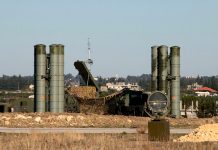
Fresh images circulating on social media have reignited debate over the status of China’s next-generation stealth fighter, the J-35. Shared by users on the platform X on June 18, 2025, the photos reportedly depict aircraft marked with serial numbers such as 3501, 3505, and 3506 during practice flights for a planned military parade on September 3. These sightings have led observers to suggest that the J-35 may have entered small-scale production—a potentially major step forward in China’s military aviation ambitions.
While some experts interpret the images as indicative of progress beyond prototype development, others caution that the jets may be featured primarily for ceremonial or public relations purposes. Chinese military parades have previously included aircraft or equipment that were not yet fully operational. For example, the 2015 Victory Day event showcased early J-20 prototypes that did not reflect active deployment.
The newly surfaced images show aircraft with the telltale features of stealth fighters: angular contours, minimal surface protrusions, and low-observable design elements. The numbered markings on the fuselage have drawn particular scrutiny, as they could imply the start of limited production. However, without official confirmation or supporting evidence—such as satellite data or verified flight logs—it remains unclear whether the J-35 is mission-ready.
The J-35, developed by Shenyang Aircraft Corporation, is a twin-engine stealth aircraft designed to serve alongside China’s J-20 and potentially operate from aircraft carriers. An evolution of the earlier FC-31 prototype unveiled in 2014, the J-35 sports enhancements that reduce radar visibility, such as inward-canted vertical stabilizers and enclosed weapons bays.
Roughly the size of the American F-35, the J-35 is built for multirole versatility, including air combat, ground strikes, and maritime operations. Its stealth capabilities are likely bolstered by radar-absorbing coatings and carefully engineered surface geometry, although full technical details remain closely guarded.
The aircraft is believed to be equipped with advanced avionics, including an active electronically scanned array (AESA) radar system, probably developed by the Nanjing Research Institute of Electronics Technology. This radar allows long-range target detection and tracking while minimizing emissions. The jet is also expected to carry an electro-optical targeting system (EOTS), enabling identification and engagement of both air and ground targets. Integration with China’s broader digital warfare network would allow the J-35 to share data with platforms like the KJ-500 early warning aircraft and the GJ-11 stealth drone, enhancing real-time battlefield coordination.
Armament for the J-35 is thought to include the PL-15 long-range air-to-air missile—reportedly capable of striking targets over 120 miles away—as well as the PL-10 for close-range combat. For ground missions, the aircraft may carry laser-guided bombs (e.g., LS-6 series) and anti-ship missiles such as the YJ-12 in its naval variant. While stealthy operations would rely on internal bays, the J-35 can also carry weapons externally if radar evasion is less critical, albeit at the cost of reduced stealth.
When compared to existing platforms, the J-35 represents a potential alternative to the U.S. F-35, which has been widely adopted across NATO and allied forces. Though the F-35 boasts unmatched sensor integration and operational experience, the J-35 could appeal as a more agile or affordable option for missions that do not require long-range deployment. In China’s arsenal, the J-35 would complement the larger J-20, offering flexibility for both land-based and naval missions.
The Russian Su-57, another contemporary fifth-generation fighter, has faced development hurdles and limited deployment, highlighting the difficulty of bringing such aircraft into active service. Like the Su-57, the J-35 will need to prove its reliability and operational viability over time.
The rollout of the J-35 aligns with China’s strategic focus on modernizing its air and sea forces. Since introducing the J-20 in 2017, Beijing has ramped up investment in stealth aviation. The naval version of the J-35 is particularly significant, as it is likely designed to operate from China’s Type 003 carrier, which uses advanced electromagnetic launch systems similar to those found on the U.S. Navy’s Ford-class carriers.
This development could mark a turning point for China’s maritime power projection, especially given the limitations of the current J-15 carrier fighter, which lacks stealth features. However, fielding a new jet on a carrier involves years of pilot training, infrastructure upgrades, and logistical planning—areas where China is still catching up with the U.S. Navy’s longstanding experience.
Historically, China has revealed military technologies gradually, often beginning with controlled public appearances. The J-20 was kept under wraps for years before its debut at the 2016 Zhuhai Airshow. Similarly, the FC-31 remained a prototype for nearly a decade before evolving into the J-35. This suggests that appearances in parade rehearsals may reflect symbolic milestones rather than confirmed operational status.
Though the presence of serial numbers implies a small fleet, this alone doesn’t confirm full-scale production. Manufacturing sophisticated fighter jets requires advanced engines and supply chain consistency—factors that may still be in development. The J-35 is rumored to use either the WS-13E or the newer WS-19 engine, both of which are still undergoing testing. In contrast, the F-35 uses the mature and reliable F135 engine from Pratt & Whitney.
Other critical considerations include maintenance networks, pilot readiness, and systems integration. These elements are essential for sustained operations and are often the most challenging aspects of deploying new platforms.
There is also speculation about the J-35’s export potential. Nations such as Pakistan—already a key customer for Chinese military exports—may express interest. The JF-17, co-developed by China and Pakistan, shows Beijing’s capacity to create export-friendly fighters. However, competing globally with the F-35 requires not only affordability but also proven performance, an area where Chinese designs have yet to fully catch up.
The J-35 emerges at a time when China is investing heavily in next-gen defense systems, including AI, hypersonic weapons, and autonomous drones. The J-35’s integration with these systems could offer tactical advantages in future conflicts. Still, without combat experience, questions remain about its readiness and durability in real-world scenarios.
China’s opaque approach to military disclosures has also fueled uncertainty. While countries like the U.S. provide relatively transparent updates on aircraft programs, Chinese platforms often appear suddenly, with little technical detail available. The lack of confirmed test results or official briefings means analysts must rely on unofficial imagery and educated guesses.
Upcoming events like the Zhuhai Airshow could provide more concrete insights into the J-35’s capabilities and readiness. Until then, its role remains speculative. From a design standpoint, the J-35 appears tailored for stealth and multirole versatility, though its exact trade-offs in range, payload, and software sophistication are unclear.
The carrier version—unofficially referred to as the J-35N—would need to withstand maritime stresses and demanding flight conditions. China’s earlier experience with the J-15, which suffered mechanical and operational setbacks, highlights the complexity of building carrier-based aircraft that match modern standards.
Unlike earlier Chinese fighters that were influenced by foreign designs, the J-35 appears to be a largely indigenous project. Advances in radar systems, materials engineering, and engine development reflect China’s growing aerospace capabilities. Still, core challenges persist, especially in software development, which is increasingly vital to modern air combat effectiveness. The F-35’s edge lies in its sensor fusion and mission systems, areas where the J-35’s performance is yet to be evaluated.
From a strategic perspective, the J-35 could fill a niche between China’s heavyweight J-20 and its current legacy platforms. Its compatibility with forward-deployed bases or aircraft carriers could extend China’s airpower footprint, particularly in contested maritime zones.
Even so, integrating a stealth fighter into a carrier fleet is no small feat. The U.S. Navy’s adoption of the F-35C took years of adjustments. China, with its growing naval ambitions, must navigate a similar path, developing training regimens, maintenance protocols, and carrier systems tailored to the J-35.
Ultimately, the J-35 could influence the global balance of air power if successfully deployed and exported. However, it faces stiff competition. While cost could be a selling point for nations unable to afford Western jets, performance and reliability will be decisive. The Russian Su-57 has struggled to meet expectations for similar reasons.
As analysts examine the recently released parade images, the J-35 continues to stir interest and debate. Whether it signifies a production breakthrough or serves primarily as a showpiece remains uncertain. Regardless, the aircraft reflects China’s serious pursuit of stealth aviation parity with the West.
The long-term impact of the J-35 depends on factors far beyond its sleek exterior: software integration, engine reliability, and operational support will determine whether it becomes a true game-changer or just another ambitious prototype.





